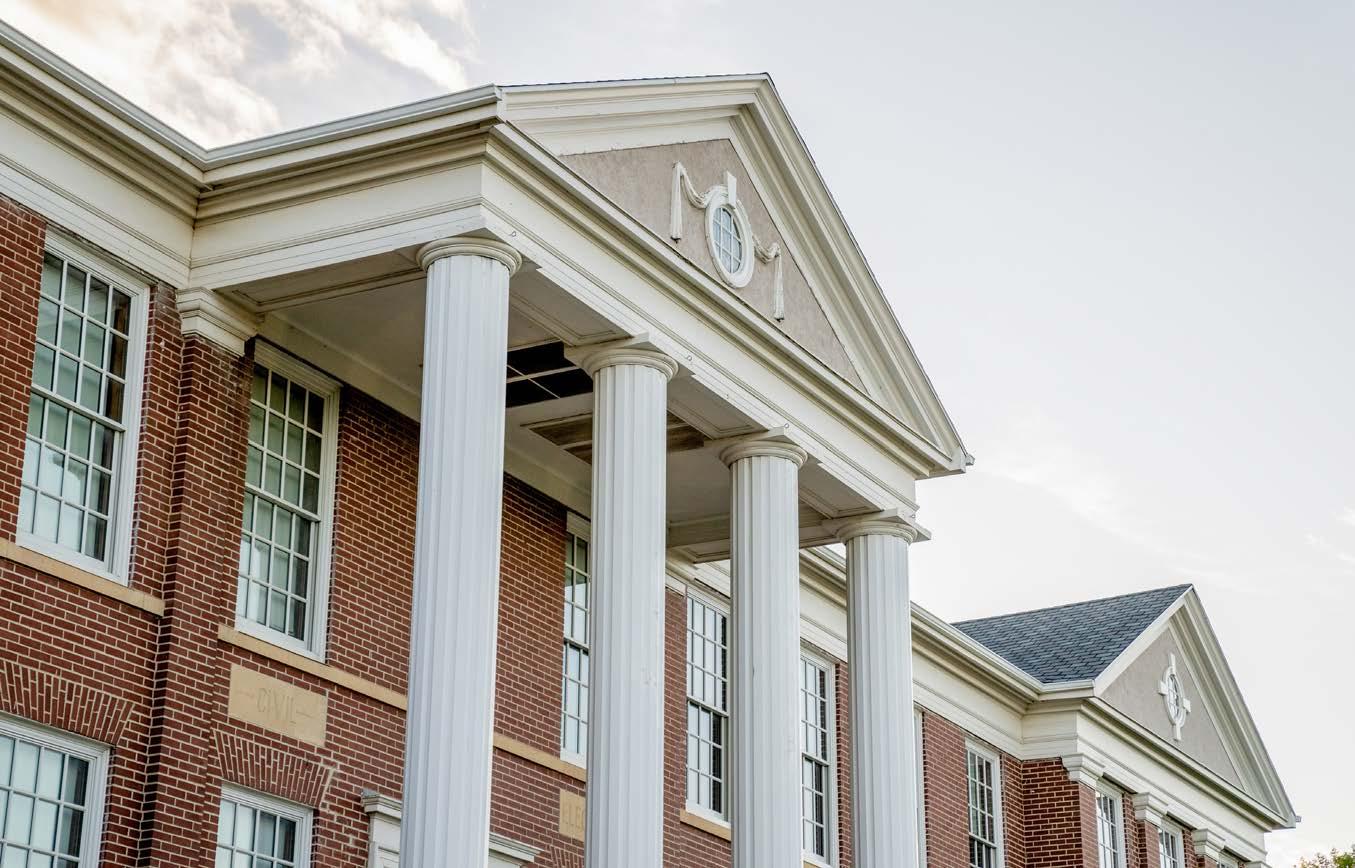




The Hardrock TM is published by South Dakota Mines. The Hardrock TM is a trademarked name of the Center for Alumni Relations & Advancement (CARA). Submissions of articles and photographs are encouraged. We reserve the right to edit for style, clarity, and content. For information, free subscriptions, a digital version, or address
corrections:
CARA
330 E. Kansas City St. Rapid City, SD 57701 605.394.2347 / 800.394.2394

cara@sdsmt.edu www.sdsmt.edu/hardrock
Executive Editor
Ann Brentlinger
Managing Editor
Mike Ray (Geol 97)
Photography
Brian Hill
Gray Hughes
Greg Latza
Mike Ray
Writers
Gray Hughes

Kathleen Fitzgerald-Ellis
Shelli Grinager
Anita Freeman (EE 76)
Mike Ray
Graphic Designer
Brian Hill
Contributors
Devereaux Library
About the Cover
The Nucor Mineral Industries building on the Mines Campus taking shape in the spring of 2023.
Ask
Women
M.R.
Corn
Building
Giants
Like
From



Class Notes
In
Alumni Gatherings

Future Hardrockers
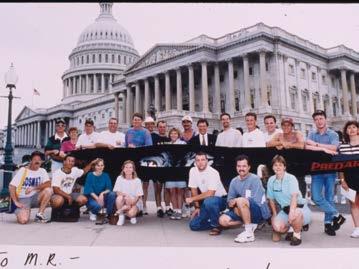
Board Chair
Julie Carver (GeolE 86)
First Vice Chair
Rich Wells (ChE 82)
Second Vice Chair
Amy Koenig (ChE 95)
Treasurer

Tim Ogdie (ChE 80)
Secretary
Toni Richardson (IS 95)
CARA CEO
Paul Krueger
Center for Alumni Relations & Advancement
330 E. Kansas City St. Rapid City, SD 57701 Office: 605.394.2347 / 800.394.2394
cara@sdsmt.edu
As we close out another school year, I know many of us are looking forward to connecting with others. Whether we’re going on a family vacation, having an annual get together with friends, or planning to spend more time in nature, summertime seems to know how to bring us together and help us reflect on what’s important.
While you consider all of the ways you’ll connect with others this summer, I encourage you to consider your fellow Hardrockers. Mines alumni share a powerful connection; I think it’s our secret superpower. The traditions we took part in as students bonded us for life, and as alumni we must hold on to those friendships and professional connections that keep serving us in our personal lives and in our careers.
Part of remaining connected to our fellow Hardrockers includes students who are about to graduate and those who recently joined our alumni community. Find out if your organization has any recent Mines graduates. Mentoring a young professional is the perfect way to remain connected to Mines and to give back to the university.
Speaking of giving back – thank you to all of you who donated during our Raising for Rockers 24-hour giving event. Collectively, 400+ alumni and friends raised $160,000+ for athletics and academic departments at Mines. For many, it was your first ever gift to Mines. Making your first donation to Mines is a milestone, marking a point in your life when you recognize your ability and willingness to give back to the university that helped you become who you are today.
Lastly, congratulations to Lorin Brass (MetE 75) on receiving an honorary doctorate from Mines this May. Lorin’s career and his commitment to South Dakota Mines is inspiring. We’re grateful for all he and his wife, Mary (CE 77), have done for Mines.
Thank you for being a part of the Hardrocker community. We have so much to look forward to in the coming year, including seeing our Nucor Mineral Industries Building come to fruition. As you can see from the front cover of this magazine, it’s coming together quite nicely.
For more information, visit https://cara.sdsmt.edu/MineralIndustriesBuilding.
Have a wonderful summer.
JULIE CARVER (GeolE 86)
P.S. I hope you’re planning on joining me and our strong alumni community on campus for Rocker Days, Sept. 15-16. More information will be coming soon!

1888
A South Dakota Mines geology class makes its first trip to the South Dakota Badlands via horse and wagon.
85 years ago
1938
The O'Harra Memorial Stadium is dedicated and the Hardrockers defeat the SD State Jackrabbits 18-7 in the first football game.
1978


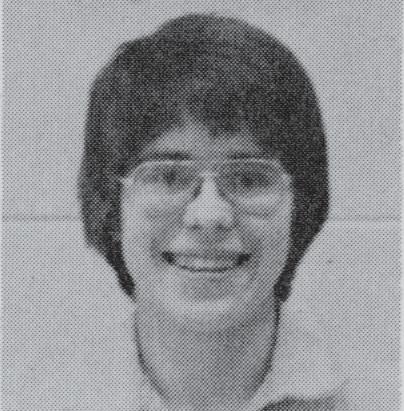



The South Dakota Intercollegiate Conference (SDIC) competition opened to women and the Tech Rockerettes Basketball Team takes first place.

20 years ago
2003
Spirit Rock is officially dedicated on campus.
 Credit to Devereaux Library
Credit to Devereaux Library
 NEEDLES HIGHWAY PHOTO CREDIT travelsd.com
NEEDLES HIGHWAY PHOTO CREDIT travelsd.com
Thanks to support from many of you, our campus is bustling with new construction and growth across many departments. The Nucor Mineral Industries Building is quickly taking shape and will open in 2024 to provide our students and faculty with cutting-edge resources. We’re in the final hurdles of our fundraising efforts, and naming opportunities for state-of-the-art labs, classrooms, and meeting rooms are still available inside the new facility.
Research on campus is also expanding at a rapid pace across a range of disciplines; bioprocessing, data science, energy storage, advanced manufacturing, and physics are just some of the several exciting areas of innovation that can spin off into high-tech industry growth.
Our partnership with the Sanford Underground Research Facility (SURF) includes a new effort to expand the underground lab space in Lead as well as to build the Institute for Underground Science at SURF. These projects will continue to provide amazing opportunities for Mines students, faculty, and alumni for decades to come.
Our partnership with the Department of Defense via the National Security Innovation Network is also turning out new student start-up businesses right here in the Black Hills. Read more about CounSill LLC, one example of many, on page 22.
As we expand research and tech-based economic development in the Black Hills, we’re not forgetting our commitment to creating world-class STEM professionals. Starting in the fall, we’re kicking off the President’s Leadership Academy, a recurring year-long program which will expose students to the skills, insights, and perspectives that define effective leaders. Our students remain in high demand. Our career fairs continually break employer and student attendance records, and we aim to continue to grow enrollment and increase the number of graduates in the coming years.
Our alumni play crucial roles in all of these efforts; we have a bright future thanks to the time, talent, and resources so many of you invest in our alma mater. I hope to see many of you during our homecoming events this coming fall, if not up on the hill on our Friday, Sept. 15 M Day celebration, then at the Hardrocker Heritage Gala that evening or at the football game on Saturday, Sept. 16.
Warm regards,
Jim Rankin (EE 78), PhD, PE President South Dakota Mines

from the Department of Materials and Metallurgical Engineering at South Dakota Mines
The events of the last few years have brought concerns over supply chains to the front of the public consciousness. One prominent aspect of these concerns revolve around “critical materials," which are metals and minerals that are essential to the running of modern economy, but have little domestic production. The list of these materials is worryingly long, and includes
metals like cobalt, nickel, manganese, lithium, and the “rare earths,” also known as the lanthanide metals, examples of which are neodymium and samarium.

South Dakota Mines is uniquely suited to help the country address these problems. As one of the few universities in the country to have the necessary combination of geology, mining engineering, and metallurgical engineering under one roof, the school can leverage its expertise to help in the production of these critical minerals. This will involve a two-pronged approach involving both research and workforce development.
To meet these challenges, the utilization of both traditional and nontraditional resources will be needed. This will involve research into the utilization of new ore deposits as well as the development of recycling and waste utilization technologies. The solution to the critical minerals problem will also require the training of the next generation of engineers, who will need the knowledge and skills to find creative solutions to these issues. Here at South Dakota Mines, we will help to meet these challenges head on, providing a bright future for our graduates and our country.
September 15, 2023
Read about our 2022 winners on page 38.
Student Mason Teal was introduced to Scott Rausch (EE 75), active alumnus, instructor and avionics industry expert, during his freshman year EE 110 course.
“He gave a presentation on his experience in industry, showing us the various aircraft he had worked on, and I remember thinking, ‘Wow, I want to be like this guy. I could learn a lot from him,’” says Teal.
One of the projects the two were working on was creating a learning board to help other students understand Programmable Logic Controller. Sadly, the project wasn’t finished, as Rausch unexpectedly passed away in April of that semester.
Recognizing the need to solidify Rausch’s impact on Mines, his family, friends and fellow alumni raised over $1 million to name the avionics lab after him.

“It’s very moving to see everyone come together to support the new Scott Rausch Avionics Lab and the endowment that will sustain current and future Hardrockers,” says Mines President Jim Rankin (EE 78) PhD, PE. “There is nothing that Scott would have wanted more than to know the avionics students are being supported and that his impact on this campus will be remembered forever.”
The avionics lab includes a fully equipped flight simulator that mimics a wide range of aircraft and that allows students to test and develop new avionics software and hardware. The program is housed in the Department of Electrical Engineering and Computer Science, which added an avionics minor in the fall of 2021.

Rausch spent decades in the aerospace industry; in retirement he devoted much of his time to South Dakota Mines alongside his wife, Linda (ChE 75) .
Thank you to the alumni and friends who supported the Scott Rausch Avionics Lab Fund.
The Scott Rausch Avionics Lab was dedicated on March 7. A plaque honoring Scott is located inside the lab. Back row: Jody Rausch, Linda Rausch, Ken Miller, James Pickering, and Alan Rauschmodeling for fancy cowboy clothing companies, or even good old-fashioned cattle ranching are not pursuits that benefit from a robust engineering education—but Stephen Yellowtail (IE 17) would beg to differ.

“People don’t think about it, but engineering is 100 percent applicable to the ranching world,” Yellowtail says, as he drives a pickup full of hay across


including an emerging career as a Hollywood stunt man and work as a model for western clothing companies. He’s doing all this while continuing to run his family ranch.
“I’m very fortunate that my cattle operation has grown thanks in a big part to the education I received at Mines. I plan to keep expanding,” he says.
Yellowtail attributes his success to not only the math, engineering, and organization skills he learned at Mines, but also the people skills.
“There are some values you learn from sports that are super huge and that maybe are sometimes overlooked,” he says. “From my experience, teammates and coaches were a brotherhood at Mines. Coach Henry and Coach Glenn wanted to see us all succeed.”
Today, he also wants to share that success with the next generation of young people who may dream of careers in STEM, but who might not think they are attainable.
the Montana high prairie to his cattle pasture. “The knowledge I gained at Mines has been a huge help. In industrial engineering, you take a lot of courses related to finances, quality control, and optimization. Whether it’s producing the best beef possible or stunt doubling, it’s a business,” he says. “Mines taught me how to excel in these endeavors.”
Yellowtail is a fourth generation Montana cattle rancher, member of the Crow Tribal Nation, a father of two boys, a South Dakota Mines basketball player, and Tiospaye Scholar who rose to national stardom as a 2021 finalist in INSP’s cowboy competition television series Ultimate Cowboy Showdown. His second-place finish on the show spun off into more industry opportunities
“I took a class on professionalism that was really valuable,” he says. “I get stuntman gigs and modeling gigs and I have to represent myself as a business. Knowing what my skills are and being able to negotiate my worth, is something I picked up at Mines. Yellowtail also gives praise to the supportive community of professors and Native students on campus. “The Tiospaye Program was extremely helpful in my current success. People like Dr. Carter Kerk and their effort to build that community on campus was so important. I don’t have enough good things to say about Dr. Kerk."
He is also proud to represent South Dakota Mines as a Native alumnus. “The number of Native people both in engineering and the movie industry is really small,” he says. “At Mines we were ambassadors for Native people and that continues today."
“It was such a great pleasure to have Stephen in the Tiospaye Scholar Program, largely because of his enthusiasm and positive attitude,” says Carter Kerk, PhD, professor of industrial engineering and the Tiospaye Program director.
As a scholar athlete and basketball player, Yellowtail says he values the lessons learned on and off the court.
“My advice to young people interested in STEM who might be from a tribal nation is just go for it,” he says. “I understand, coming from a reservation as a young person, it just looks totally unattainable. I remember thinking, there is no way I can get off the rez, there is no way I can go to a college. For some of these kids, to even dream of these things is just unheard of. I want them to know, there are people out there who want them to succeed. ”
Yellowtail is continuing to find success. He is stunt doubling for actor Martin Sensmeier in the television series 1883. He spent last summer working on the Kevin Costner film Horizon that is bringing him back for the next installments of the three-part saga. Despite the success in the movie industry, he remains humble and plans to keep ranching, above all. “The cattle business is my bread and butter and I’m very fortunate,” he says.
Yellowtail is one of 58 Native American students to graduate from Mines since the Tiospaye Program began in 2010. The purpose of the program is to recruit, retain, and graduate increased numbers of Native students in engineering and science by providing financial, academic, professional, cultural, and social support.
sdsmt.edu/tiospaye
One could argue that acting as a Hollywood stuntdouble,

 Stephen Yellowtail’s engineering education at Mines as a Tiospaye Scholar empowers his current Montana ranching operation and his jet-setting Hollywood career.
Stephen Yellowtail’s engineering education at Mines as a Tiospaye Scholar empowers his current Montana ranching operation and his jet-setting Hollywood career.
The American Association for the Advancement of Science (AAAS), the world’s largest general scientific society, named Mines Professor, Department Head, and Museum Director Laurie Anderson, PhD, to its 2022 class of Fellows.

AAAS fellowship is one of the most distinct honors in the scientific community. Anderson is the first woman to be named an AAAS fellow while employed at a South Dakota university. She is one of only three current AAAS Fellows in the entire state. The organization’s database shows that Anderson is among a small number of individuals in the history of South Dakota who have been named AAAS Fellows.
“This honor for Dr. Anderson is so very
well deserved,” says South Dakota Mines President Jim Rankin (EE 78), PhD, PE. “It’s wonderful to see her distinguished work as a scholar properly recognized by the scientific community. She also deserves high praise for her leadership on campus as a celebrated mentor and advocate for faculty, staff, and students. She is an excellent reflection of all of the amazing individuals we are fortunate to have at Mines.”
Anderson leads the Department of Geology and Geological Engineering at South Dakota Mines and is the director of the Museum of Geology on campus. She is a paleontologist; her research focuses on reconstructing past environments by understanding the life, death, and fossilization processes of clams, oysters, and other marine and freshwater creatures. She is an
expert in paleobiology, paleoecology, taphonomy, and phylogeny of mollusks, particularly Bivalvia.
Anderson has a distinguished career that includes work all over the world, including in the Amazon, along with research in Louisiana, Mississippi, and Alabama following the Deepwater Horizon oil spill. Besides field work, her scholarship also includes research in modern and ancient coastlines, ancient freshwater lakes, statistical analysis of shape, and geochemical datasets.
Sarah Keenan, PhD, assistant professor in the Department of Geology and Geological Engineering at Mines, agrees that Anderson deserves recognition for both her scholarly work and her leadership. “Dr. Anderson continues to serve as an inspiration for paleontologists and geoscientists,
and for women in academia. Her leadership, contributions to research, and education and mentorship are more than deserving of the highest honor of AAAS Fellow.”
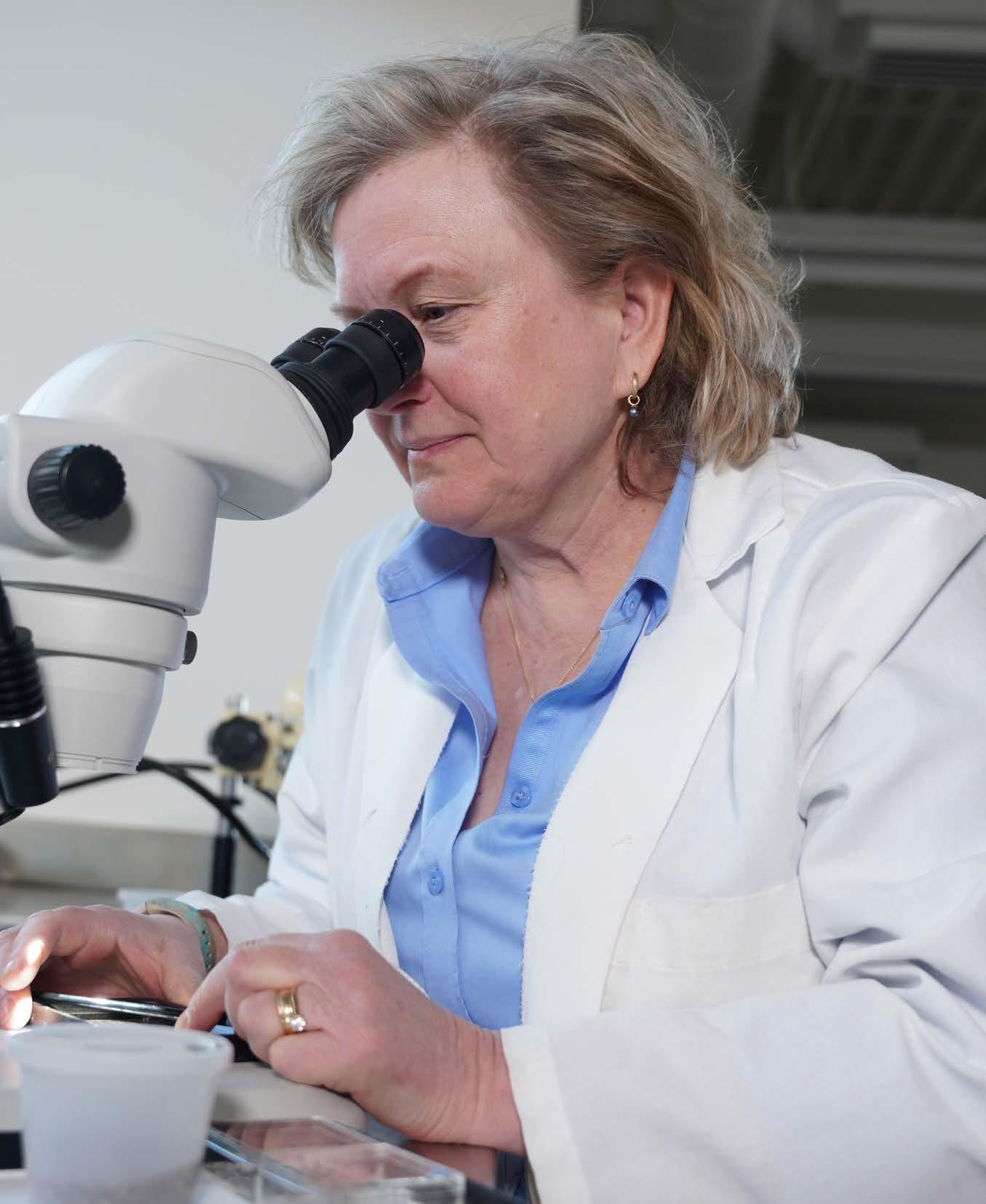
Anderson received a BA (summa cum laude) in geology, biology, and music from the University of Minnesota, Morris in 1985. She went on to complete an MS in geology in 1987 at Bowling Green State University, where she held an Amoco Foundation Geology Fellowship. She earned a PhD in geology at the University of Wisconsin-Madison in 1991. While at Madison, she received a Wisconsin Alumni Research Foundation Fellowship and a Shell Companies Foundation Fellowship.
In 1991, Anderson joined the faculty in the Department of Geology and Geophysics at Louisiana State University.
the geology and geological engineering department head and director of the Museum of Geology. She also served as interim head of the Department of Mining Engineering and Management in 2019-2020.
While at LSU, she received the College of Basic Science Research Award, Dr. Henry V. Howe Distinguished Professorship and the Harrison Family Field Camp Professorship. She also served as LSU faculty senate president and chair of the Department of Geology and Geophysics. She came to South Dakota Mines in 2011 to serve as
Anderson will receive a certificate and a gold and blue rosette pin (representing science and engineering, respectively) to commemorate her election as an AAAS Fellow. Her achievement will also be celebrated in Washington, D.C., in summer 2023. She was featured in the AAAS News and Notes section of Science magazine in February 2023 along with the list of other most recent nominees.
"This honor for Dr. Anderson is so very well deserved."

When I arrived on campus for my freshman year in 1972, I was assigned a room on the third floor of Dake Hall. The dormitory was two separate, three-story buildings named for Guy “Pop” March and Earl Dake that were joined in the center with a common lobby entry with the only television, and an apartment for a housemother. Third floor Dake was comprised of two wings, with a lounge in between.
I soon realized that third floor Dake was the only housing available for
women on a campus of 1,500 students. Women first began living there in 1968. There was occupancy for 32 women who were freshmen and sophomores, and living in the hall was required unless you were from the Rapid City area. All of March and the first two floors of Dake were occupied with freshmen male students as well as offices for the atmospheric sciences department.
The entry doors to the floor were locked at all times and male students were not allowed on the floor. Initially, there was a curfew of 11 p.m. on week nights and 1 a.m. on Friday and Saturday. In the early years, no one broke the curfew or dared stay in someone else’s room, because rumor had it that women would lose housing rights if they misbehaved.
Since there were only a handful of women in the dorm, the resident advisors (RAs) would walk around and check to make sure everyone was in their room in the evenings. The first RAs on the floor were Kathy Kutcher Stechmann (Math 69) and Diane Gleason Hammond (Math 69). Third floor Dake wasn’t for women when Diane and Kathy were first- and second-year students, but they jumped at the opportunity to be RAs when it opened in their junior year.
Mary-Jane Seeley Green (CE 78) remembers that initially, in order to be away from the dorm over the weekend, women were required to have a letter or call from a parent or guardian to the housemother, Mrs. Mary Jones. On Beanie Raid nights, the seniors had to get permission to take the freshmen girls away from third floor Dake so they wouldn’t get in trouble for leaving after curfew.
Janita Preston Smith (Chem 77) said that the phone in the lounge felt like their lifeline to the outside. “Many a date began or ended with a phone call from the joint lounge,” she said.
Over time, the rooms on third floor Dake filled, and the curfew changed to 10 p.m. There was a tiered penalty system for missing curfew. The first infraction meant you had to stay on the floor from 6 p.m. to 6 a.m. on the next Saturday. The second infraction meant you needed to stay on the floor both Friday and Saturday. And the third infraction resulted in a trip to the Dean of Students office.
One downside of third floor Dake was that it was built to be a men’s residence hall. Each wing had a shower room with three heads, a curtain instead of a door for bathroom stalls, and just two sinks. There was a tradition of putting plastic flowers in
the urinals every fall after men had used the floor in the summertime. Over time, we heard the bathroom situation became a detriment in recruiting females to the university, which is not a surprise!
Students at the local nursing school
Whist,” she said. “We still play when we get together for reunions.”
On one occasion, the women decided to play poker.
“We gathered in my room instead of the lounge,” Linda said. “We had
were taken to Rapid City General Hospital to see new babies.
After graduation, we stayed in touch through Pop March’s alumni newsletter, called “ The Hardrock ”, which was our version of today’s social media. We have watched each other’s children grow up, have seen one another become grandparents, and sadly, we have had to say goodbye to a few of the remarkable women we came to love.
“It’s hard to believe all we had were 32 women living on campus,” said Susan Nemeth Davidson (ChE 77).
took classes on our campus, so we came to know them well. One Saturday afternoon, we went to their dorm, and they put a cast on our RA’s left arm. The RA stopped by the housemother’s apartment, where a number of students were gathered, and the RA garnered a lot of sympathy for her injury. When flowers arrived, she thought it best to come clean and remove the cast!
There were a lot of Trekkies, and the men and women would all gather in the common lounge just before 6:30 p.m. on the evening that Star Trek was aired.
“We were so disappointed when the show was canceled,” says Seeley Green.
Linda Rausch (ChE 75) remembers the women played a lot of cards.
“Whenever there were four people in the lounge on third floor, we played
a supply of Swisher Sweet cigars to add to the ambiance. The windows were opened wide, in spite of the cold temperatures. Fun was had by all, but we never repeated that event. It took weeks for the smell to dissipate.”
Karen Wenig Werner (MinE 76) said it was always a pain to do laundry with limited machines in the basement, but adds, “I don’t think the guys ever used them, so that helped!”
According to Preston Smith, the women of third floor Dake really stuck together. “I loved that there was almost always someone to hang with if you wanted to get away from the books for a while.”
After two years on third floor Dake, women paired up to live in apartments near campus for the last two years. It was musical chairs for roommates, as girls got married or living situations changed. We had wedding showers and baby showers, and many trips
We were an eclectic group of personalities, but with a common focus in STEM, and we truly bonded.
Additional Contributors:
Mary Halling Kennon 1971-1972
Susan “Booty” Kuhns 1971-1973
March-Dake Hall was removed from campus in 2002, but a group of us had a chance to visit it one last time before then. It may have been our unusual living conditions on a maledominated campus, but after 50 years we still have these special friendships and look forward to the five-year alumni reunions.

Carmen Pauling Adams 1971-1973
Kathy Kelly Miller 1970-1972

Jeane Hudson Hull 1973-1975
June Heinrich Busse 1973-1975
Marilyn Maxvold 1972-1974
We hope the women on campus today have as many fun traditions as we did, and we’re glad that today there are more than 32.
A group of 3rd floor Dake ladies got together May 5th to reminisce. Pictured are April (Brady) Anderson, Vickie (Pollock) DeNeui, Karen (Sewell) Hearne, Cecelia (Rensch) Day, Mary-Jane (Seeley) Green, Judy Cannon, Sue (Schmidt) Kutcher


M.R. Hansen (CE 69), PhD, PE, a longtime civil engineering professor at South Dakota Mines, has deep roots in the state. He grew up in the town of Philip, son of a Wall Drug sign painter.


“My dad survived WWII with a Silver Star and Purple Heart,” Hansen says. “He made his living and supported ten kids by painting signs. His best customer was Wall Drug."
Hansen was like many young people who came to Mines from small towns across the Midwest in that his hard work on campus changed his fortune.
“We were dirt poor, but when I got to Mines, I really connected. I appreciate that. I just want to give back,” he says.
Hansen spent nearly 40 years giving back as a faculty member. Today, he’s continuing the legacy with the formation of an endowment in support of student scholarships and activities in civil and environmental engineering.
“This endowment goes to civil engineering and scholarships along with funding for the student chapter of the American Society of Civil Engineers (ASCE), Concrete Canoe, and Steel Bridge teams.”
For students, the endowment is already making an impact.
“This endowment allows us to experience more things outside of campus; it helps us attend conferences and competitions,” says Haden Casdorph, ASCE student chapter president at Mines. “There are significantly more opportunities for us thanks to this endowment.”
Even though they didn't qualify last year, student members of both the Concrete Canoe and Steel Bridge teams attended the 2022 national competition.
“We were able to see things all around the world and learn the level of competition we are up against. This gave us a real head start on this year,” says Ben Lewis, 2023 Concrete Canoe team captain. “This trip helped us be more competitive,” says Ruth Potter, the 2023 Steel Bridge captain.

The investment Mines alumni have made into the M.R. Hansen Endowment is already seeing returns in student success. Both the Steel Bridge and Concrete Canoe teams won the regional competition in 2023 and will take part in nationals in June of this year.
Hansen points out that even small gifts, the types of funding that can help cover student travel, can go a long way in assisting students at Mines. “We’re not necessarily looking for million-dollar donations; small donations can make a big difference,” Hansen says.
The endowment has also paid for three student scholarships: Kade VanDusseldorp, Carson Daly, and Brian Pfeifle. For students, this is a game changer. “Without the help of a scholarship, like the M.R. Hansen & Friends Scholarship, many students would have a much harder time figuring out how to pay for their education,” says Pfeifle.

The long-term goal is to find ways to sustain the fund for generations to come.
“The trick is to make the fund self-building,” Hansen says.
Hansen started a Facebook group for the endowment as a way to connect alumni to the cause. Those who wish to contribute can also visit the CARA website: https://cara. sdsmt.edu/ways-to-give, then under Donation Information, Give To, scroll down to click on "other," and then type in “M. R. Hansen and Friends Endowment.”
Brian Pfeifle Carson Daly Kade VanDusseldorp

 NASA NEXT-GEN BATTERY BREAKTHROUGH FUELED BY MULTIDISCIPLINARY COLLABORATION AT SOUTH DAKOTA MINES
Dr. Weibing Xing, (second from left) and his research team (from left to right): Gulam Smdani, Weibing Xing, Haiden Studer, Wahid Hasan, Amir Razzaq, Chris Poches, and Salman Khan Mithil) in a next-generation battery research laboratory at South Dakota Mines.
NASA NEXT-GEN BATTERY BREAKTHROUGH FUELED BY MULTIDISCIPLINARY COLLABORATION AT SOUTH DAKOTA MINES
Dr. Weibing Xing, (second from left) and his research team (from left to right): Gulam Smdani, Weibing Xing, Haiden Studer, Wahid Hasan, Amir Razzaq, Chris Poches, and Salman Khan Mithil) in a next-generation battery research laboratory at South Dakota Mines.
South Dakota Mines has received a new $750,000 NASA EPSCoR grant to fund research into the next generation of lithium-sulfur batteries for use in space technology. The grant comes following a breakthrough on campus into a new polymer-biocarbon cathode coating made from corn stalk residues that stabilizes next-generation battery chemistry to nearly double the charging capacity of current technology.
A press release from NASA on this research states, “Improving the power capacity and life of batteries could help NASA power rockets, spacecraft, and habitats on the Moon, and eventually, Mars.”
The breakthrough began with the work of Rajesh Shende, PhD, on finding new uses for biorefinery waste leftover from the bioprocessing plants, such as those that turn corn into ethanol. Shende and his team of researchers found that agriculture residue such as corn stalks, or stover, could be turned into a battery-grade biocarbon. PhD students
Khang Huynh and Bharath Maddipudi worked with Shende to develop a polymer-coated porous carbon for energy storage applications. Then, in 2020, Weibing Xing, PhD, joined the mechanical engineering department at Mines. Xing’s expertise is in next-generation lithium batteries.
“Lithium-sulfur batteries are widely regarded as the most promising next-generation batteries with the highest energy density,” says Xing.
But Xing notes there are inherent problems with the chemistry of lithium-sulfur batteries that reduce their ability to store the full amount of energy they should be able to hold. At Mines, Xing began working with the Center for Solid-State Electric Power Storage and the Governor’s Research Center for Electrochemical Energy Storage on the problems with lithium-sulfur batteries. Shende reached out to mention the possibility that the battery-grade biocarbon his team developed from corn stover might be useful in Xing’s research.
“We thought, what the heck, let’s try it,” says Xing. “We coated a nano-layer of the biocarbon on the cathode of a lithium-sulfur battery. This had never before been done in the world,” says Xing.
To the surprise and delight of the research team, it worked.
“All the sudden instead of somewhat low energy storage, the battery went to nearly its full theoretical storage capacity,” says Xing.
The new polymer-biocarbon cathode coating worked so well in these batteries that the team wanted to triple check their
work. “We could not believe it,” says Xing. “We were asking, ‘Is this real? Is this actually true?’” So, the team retested the material and analyzed the results with several methods. In the end, the results held up.
“If you go looking for these breakthroughs they never seem to happen, you sort of have to stumble on one,” Xing says with a smile.
The unique nano-thin layer of polymer coated biocarbon on the cathode side of the lithium-sulfur battery helps stabilize the chemistry inside batteries and increases their storage capacity. This breakthrough is thanks to the multidisciplinary collaboration and culture at Mines.
“This is the beauty of collaboration,” says Xing. “This is something that would not happen at a bigger university where research is more walled off,” says Ed Duke, PhD, a professor of geology and geological engineering at Mines. “This is how discovery is so often made,” Xing adds.
The grant, thanks to NASA EPSCoR, allows researchers to continue to study this material and optimize its potential in next generation batteries. Other faculty who will take part in this research at Mines include Tula Paudel, PhD, assistant professor of physics, and Alevtina Smirnova, PhD, a professor of chemical and biological engineering. The grant also brings in NASA researchers who will work alongside those at Mines and others like Haoran Sun, PhD, a professor of chemistry at University of South Dakota.
“There is something of a critical mass on energy research going on at this campus and in the state,” says Duke. “Thanks to this grant, we are being joined by those at NASA to continue this research.”
Xing says future research will work on other challenges with these batteries including reducing their flammability and continuing to optimize capacity. He has several graduate and undergraduate students already working in his state-ofthe-art lab on campus.
“We are very excited to work on this very advanced lithiumsulfur battery technology,” he says.
Xing adds there is immense commercialization potential in this technology. The broad range of applications could include everything from large-scale energy storage for power plants to national defense, along with multiple uses in everyday life from cell phones to electric cars. Thanks to NASA, those future applications also include space travel.
“It’s nice to think that someday material derived from South Dakota corn stalks might be part of the batteries on NASA space missions,” says Duke.

“This is something that would not happen at a bigger university where research is more walled off”
In the summer of 1972, after completing his first year at Mines, Ken Miller (CE 75) and his family were going through one of the most challenging times, to say the least. Miller’s mother had contracted an infection after an operation. Shortly after she was transferred to the Mayo Clinic’s St. Mary’s Hospital, his mother lost her battle.

Miller returned to campus after his mother’s funeral, and he began his sophomore year. Charlie Schultz (ChE 73) , a senior at that time, approached Miller in the Theta Tau fraternity house where they were living. “He said, ‘I don’t know what to say, but if there’s anything we can do, just ask.’”
Miller initially saw this as a nice gesture, but then he remembered that included in his mother’s hospital bill were 38 units of blood. At the time, his parents didn’t have health insurance, and the bill was close to a couple of years of income for Miller’s father.
“I contacted the executive director of the blood bank in Rapid City and said ‘Is there any way we can hold a blood drive and replace those 38 units of blood?’”
The director was pretty sure Mayo Clinic wouldn’t adjust the hospital bill, but he offered to check. It turns out, Mayo Clini c said they would write off the 38 units of blood if Miller could reple nish them.
In March of 1973, 50 years ago, Theta Tau had what MIller believes was the university’s first ever blood drive. It resulted in 52 u nits of blood.
“The results of that were immeasurable to my family,” Miller says.
“What’s amazing to me is that every member in town stepped up to donate,” he says. “There were even four women from third floo r Dake who came down and donated.”
Since then, blood drives have become a regular event on campus. Miller, now retired and an instructor in the mining engineering and management department, regularly donates with his wife.
“Isn’t it amazing how just one comment from a caring person can snowball into a huge, life-giving experience that’s still rolling down the hill?”
“I hope all who donate realize it’s a lifelong way of giving back to the community,” Miller says.
In addition to teaching at Mines, Miller is a donor, a member of the University Choir, and a former member and officer of the CARA Board of Directors. We appreciate his service to South Dakota Mines!
With the clock ticking down, tensions are high. Three seconds left...two...one! Suddenly, the deafening sound of the buzzer fills the air, announcing another glorious triumph for the Hardrocker team! As the players join forces in a jubilant celebration, it’s clear that this victory was hardfought and well-deserved.
What comes to mind? Football? Basketball? Well, in this case, you’d be wrong. This is e-sports, and Mines boasts a highly competitive squad.
Oftentimes, when people think about playing video games, they think about the kid sitting in their basement by themselves, no interactions with others. But that’s not the case at South Dakota Mines. If you have a passion
for gaming, then there’s a spot for you in the e-sports community at Mines. The team competes together in the e-sports room in the Surbeck Center, and there’s a flourishing Discord (an instant messaging platform used commonly by gamers) community filled with over 200 students all with the same passion: gaming with their friends.
But we’ll get to that later. First, a little background.
Initially, varsity e-sports fell under the Mines Athletic Department, and the club was a separate entity. But, this year, the two now fall under CAMP.

Amy Hasvold, CAMP director, explains that e-sports is one of 11 different competition teams in CAMP, and just like all

the others, it is completely student-led and student-driven. "The move has been a good fit," Hasvold says.
“The coaches are student volunteers, the team captains are students, the student organization has a president, vice president, secretary, treasurer as well as captains that run their varsity teams and then their recreational teams,” Hasvold says. “We just assist them along the way, but they really run their program.”
Competitively, Mines has 35 varsity e-sports players who compete in Valorant, Overwatch, League of Legends, Rocket League, and Super Smash Bros. Members of the student org also play these games and more, such as Minecraft, Apex Legends, and Halo.

Both the competition teams and the club organization work well together, Hasvold added. The student organization now has all the same resources that the varsity players have, and the varsity teams benefit because their rosters are fed by members of the organization. Last semester, Hasvold said about 120 students used the computers located in the e-sports room – both those playing in competitions and recreationally.
The Mines varsity team streams its games on a platform called Twitch, which can be monetized. Like watching football, baseball, or another sport on the TV, e-sports has announcers that commentate on the game. In addition to having people play the games, Mines also has a stable of people who will commentate on the games just like Joe Buck does for Monday Night Football on ESPN.
Nicholas Thompson, a senior physics major at Mines who is affectionally called Coach T by members of the e-sports community, oversees the streams for the club, and says last semester, the club made $200 on their streams alone.


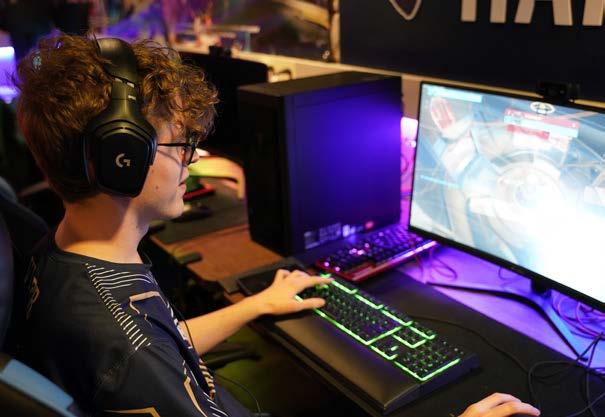
“The stream team, when I first started here, was nonexistent. I was the last officer to be appointed by our founder, and my job was to maintain the streams,” Thompson says. “I was officially the officer of streams and publications for a year. Throughout the years, it’s changed. The title has been thrown around with different name changes, but the job has stayed basically the same.”
Streaming the games as a caster, what those in the e-sports community call the commentator, isn’t what attracted Thompson. It’s the community, teamwork, and fun with your friends.
“Community is super important to us at e-sports,” Thompson says. “When you think about video games, everyone’s parents are like, ‘Oh, you’re not learning anything, you’re not going to get anything out of it. You need to be more social.’ But what video gaming has become is the ultimate social platform. We’ve grown so

close together just by playing games. We’ve learned to work together as a team to figure out solutions, and I think it’s just become a huge deal in general to the world.”
“We’re a family,” Thompson says. “We stick together, we work together, even when it comes to homework. The people I’ve grown with and became my friends are now helping me with my homework and stuff that would’ve been very hard for me to figure out on my own.”
Hail Berg, a sophomore chemistry major, serves as the president of the e-sports club and describes the e-sports community at Mines as “goofy.”
“There’s a lot of joking, and pretty much everyone with a role in e-sports are all friends,” Berg says. “I am friends with basically everyone in the cabinet and most of the people who work with e-sports, like varsity. I know them very well, and it’s just very together.”
Coming to Mines was an easy decision for Berg because of the university’s chemistry program, but it’s easy to stay because of the connections and friendships made through the e-sports community.
“It is a bunch of nerds, my kind of people,” Berg says.

The e-sports room is open to everyone. That’s how the organization was able to get Divo Cerjan, a geological engineering student from Croatia, in the door. Cerjan didn’t know Mines had an e-sports community until arriving on campus. One day after walking into the
Surbeck Center and talking to members of the club, Cerjan joined on the spot and now serves as the varsity e-sports coordinator overseeing all the competitions.
“When I first joined the club, honestly it helped me make friends and get to know people,” Cerjan says. “It was a really good way of meeting new people because we all had the same interests.”
Like both Berg and Thompson, it is the community that truly makes the e-sports team special.
“Just having people around that you can talk to and always have someone there, I feel like that’s a really cool thing,” Cerjan says.
Another important aspect of the e-sports team is the outreach component. Throughout the year, the organization hosts various events geared towards the general community, such as Grubby Games held every fall.
Grubby Games is a 24-hour LAN party, meaning that people from across the Rapid City community can come together and game at the same time in the same place. There’s a charitable component to this event with money raised going to the Children’s Miracle Network.

The Grubby High School League is an outreach event for high schools in the Black Hills area. The teams that make
it to finals play the final match in the Mines e-sports room. This year, they’re playing Valorant, but in previous years they’ve also played League of Legends and Rocket League.
On top of that, e-sports has a presence at every Go To Mines event. This provides an opportunity to get future Hardrockers excited and assures parents that their son or daughter will find a place they fit in because the Mines e-sports community is not only about playing video games in solitude but also building community, teamwork, and friendships
The rise of e-sports is undeniable and the community at Mines is proof of its growing popularity. With the revenue generated from streaming and a sense of camaraderie, it’s no wonder that e-sports is becoming a billion-dollar industry.
So begone those thoughts of students playing video games, sitting in a basement by themselves. The e-sports community at Mines proves that it’s just the opposite.
South Dakota Mines took home first place and four out of five top spots in the student division at the 2023 South Dakota Governor’s Giant Vision Business Competition held in April in Sioux Falls. The competition is highly competitive and is the biggest of its type in the state. Mines students or alumni have received top honors at the competition for ten years in a row.
Mines has taken home first place at every statewide business competition open to university students this year. This includes top honors at University of South Dakota (USD) and Dakota State University (DSU) competitions. In the past nine years, Mines

students have won nearly $80,000 in prize money from the Governor’s Giant Vision Student Division alone. These winnings account for more than double taken home from universities across the state during the same time.
“Our ongoing success in statewide business competitions is thanks to the drive and hard work of our students and all of those on campus and in our community who support our Student Innovation Cycle,” says Mines President Jim Rankin (EE 78), PhD, PE.
The Student Innovation Cycle at Mines includes the CEO Business Competition, the Engineers Make Great Entrepreneurs
Speaker Series, Braun Student Inventor Award, Spark Prototype Development Fund, and professional assistance from the university’s volunteer Entrepreneurs-inResidence and much more.
“We are very happy with how all our teams did this year. This success represents a lot of work on the part of the student entrepreneurs and all the mentors that spent so much time with them. In light of the high level of competition from all the other schools in the state, we could not be more pleased,” says Joseph Wright, associate vice president for research and economic development at Mines.
John Barbour (ChE 23)CounSil, LLC, a business started by Mines chemical engineering major John Barbour won first place in the student division of the Giant Vision competition. The company seeks to serve software needs within the United States Department of Defense (DoD). Barbour’s journey toward launching his own company took a leap forward when enrolled in the semester-long course Hacking for Defense at Mines, which is run by the National Security Innovation Network (NSIN). Barbour’s experience in this course opened the door to an NSIN X-Force Fellowship in the summer of 2021. During this fellowship, Barbour was connected with real-world problems at the DoD and tasked to find a solution.
During the X-Force Fellowship, Barbour joined fellow student Sebastian Nau at Texas A&M; they later brought on Manasy Manoj, who also took part in the Hacking for Defense course at Texas A&M. The trio was then introduced to top brass at Ellsworth Air Force Base. Their problem to solve was an antiquated system for prioritizing needs on base with available funds from different pools of money at the end of every year.
Through NSIN, Barbour and his team were able to work directly with military leadership. In a series of meetings, they learned the details of the problem, its variables and the challenges in overcoming the issues they faced.

“The ability to have access and talk to these different groups of DoD leaders was a pretty incredible opportunity; this is thanks entirely to NSIN,” he says.
Through this process, Barbour and his team were able to begin the problemsolving process and the solutions they have proposed have now spun off into their own company.
“The main priority of CounSil, LLC is speeding up the Air Force’s ability to become mission ready quickly while optimizing the amount of funding available,” says Barbour. “Given that Ellsworth is now in the process of scaling up to take on the B-21 Raider, this is an issue that will only get more complex for base leadership.”
Barbour’s initial success with the DoD also opened the door at Elevate Rapid City’s David Lust Accelerator Building (DLAB), where the company now has an office. The business incubator gives start-ups and small businesses, like CounSil, LLC, a low-cost place from which to launch their business. The incubator provides a wide-range of resources to help get new businesses on their feet. Barbour says it’s a game changer.
“This has been an amazing resource not only to be in this incubator and to access these resources but also to be around all these like-minded entrepreneurs in this environment,” says Barbour.
“John deserves a lot of credit for his incredible drive and determination to make all of this happen,” says Rankin.
Vizion UAS, a drone imaging company that helps agricultural producers increase yields, took home third place and a $3,000 prize. The company was formed by Mines students Zack Holloway, Gerald Waterhouse, and Devin Filter.
Bio-Navitas won fourth place and a $2,000 prize. The company was formed by Mines doctoral candidates Bharath Maddipudi and Khang Huynh in the Karen M. Swindler Department of Chemical and Biological Engineering, and evolved from research at Mines on turning corn stover bioprocessing waste into a valuable form of graphite.
Score-Score, a company formed by Mines computer science and engineering majors Chami Senarath, Christian Olson, and Haakon Anderson took home fifth place and a $1,000 prize. Score-Score is a database and networking application designed to aid directors in the struggle of programming
concerts through centralization and discussion of ensemble music. The team worked closely with Haley Armstrong, DMA, associate professor and Music Center program coordinator at Mines.
Mines students, alumni, and faculty have a history of success in the open division at the Governor’s Giant Vision competition, with the most recent win in 2022.

In the 2023 open division, CellField took second place and a $10,000 prize. The company created a human analogue testing device that decreases drug development costs and reduces the dependence on animal models. CellField was founded by Scott Wood, PhD, assistant professor of nanoscience & biomedical engineering, and Mines biomedical engineering graduate student Hosein Mirazi.
BioBest, a company formed by Mines student graduate student Cody Allen; Mines civil and environmental engineering professor Venkataramana Gadhamshetty, PhD; and mining engineering associate professor PT Tukkaraja, PhD; took home sixth place and a $1,000 cash prize. The company makes minimally invasive, viable, bioinspired ventilation systems for effectively scrubbing the airborne pollutants and toxic fumes from mine ventilation air.
Two Mines teams also won previous statewide competitions at Dakota State University and the University of South Dakota. The agricultural biotech company Bio-Navitas, formed by students Maddipudi and Huynh, took home first place at both events. Ian Grinager, who is dual enrolled at Mines and homeschooled, also won the high school competition with his business Your Neighbor's Trailer at the USD event.
LOUIS RANCOUR, a sophomore from Wall High School, took home the top honors at this year’s High Plains Regional Science and Engineering Fair held at South Dakota Mines. His project, Stealthy Shapes, qualified to compete in the Regeneron International Science and Engineering Fair in Dallas, Texas, in May 2023.
“When they announced the final, first place overall, I was shocked,” says Louis. His experiment used equipment in his family's own military museum, located near Wasta, SD, to test the reflectivity of a variety of aircraft shapes to better understand and demonstrate stealth technology.
Louis followed directly in his father’s footsteps.
In 1986, TOM RANCOUR (CE 94) won the same regional science fair at South Dakota Mines as a high school sophomore. Tom’s project, Solar Cell Efficiency Enhancement Using a Fresnel Lens, also won first place overall, and he traveled to the international science fair held coincidentally in Dallas, Texas.

“It's a little like ‘Groundhog Day,’ but he is in my place repeating the same steps,” says Tom with a laugh. “I am looking forward to having some of the same experiences my dad did down in Dallas at the international fair,” Louis adds.
Tom went on to finish a degree in civil engineering in 1994 from South Dakota Mines and then added a master’s degree at Mines in the same
field a year later. Today, he works as a forensic engineer examining the causes of various structural collapses, often in grain bins. He says the experience at the international fair in high school was an important part of his overall career in engineering.
“Traveling to Dallas as a high school kid exposed me to people from other parts of the world and, most importantly, ideas from all around the world and people who have ways of thinking different from our own,” says Tom. “Louis was in the engineering category just like I was back then, and I’m so pleased he will get to see this event.”
This year, Wall High School did not hold its own science fair and did not send any students to the regional
LOUIS RANCOUR, A SOPHOMORE FROM WALL HIGH SCHOOL IN SOUTH DAKOTA, TOOK HOME THE TOP HONORS AT THIS YEAR’S HIGH PLAINS REGIONAL SCIENCE AND ENGINEERING FAIR HELD AT SOUTH DAKOTA MINES 37 YEARS AFTER HIS DAD WON THE SAME TOP HONORS AT THIS EVENT.

HIGH SCHOOL STUDENT WINS SPOT AT INTERNATIONAL SCIENCE FAIR 37 YEARS AFTER HIS DAD.
fair at Mines, so Tom entered Louis on his own. “I registered as our own school so we could attend this fair,” says Tom. “Louis was working on this project for over a year, but he was unable to attend previous fairs due to the pandemic. I told him, do not worry about winning an award. Just concentrate on thoroughly knowing your project and be able to clearly explain it to anyone in simple and technical terms. That is how a judge will recognize the project is the student's own work.”
Tom adds that science fairs are an important way to inspire future generations of scientists and engineers. Louis agrees. “The science fair teaches you how to talk and communicate about your project;
this will help you in the future with professional and public speaking,” says Louis.
Head judge, Tom Durkin (MS Geol 86) of the NASA South Dakota Space Grant Consortium at Mines says, “Louis did a tremendous job on his science fair project which included a lot of experimentation and testing, and he presented the results so well, both verbally and graphically. What impressed our final selection team so much was his thorough understanding of the subject and the science behind it.”
Louis is planning to continue to follow his father’s footsteps by attending South Dakota Mines. His passion may focus on mechanical engineering,
rather than civil, but Louis sees a positive future in these fields.
“Engineering and science drive our economy. Everything in our modern lives comes from these disciplines,” says Louis. “I’m very glad to hear that Louis is considering mechanical engineering at Mines. We now have an aerospace engineering minor in that department. We wish him the best at the international fair,” says Durkin.
The Regeneron International Science and Engineering Fair takes place in Dallas, Texas, in May. Tom Rancour's advice for Louis: "Enjoy the experience and do whatever activities you want to take part in at the international fair."
As we head into summer, we reflect on another successful academic year. As you have read, there is much to be proud of. South Dakota Mines is thriving. I use the word “momentum” often with our team. I like the idea that momentum means the team is in motion and making the right kind of progress.
Our mission is to support the university. We do that by engaging you through communication, events and keeping you connected to campus. We also have the privilege of working with you on your philanthropic decisions. Giving to South Dakota Mines is critical to our continued success. The needs are endless.
We have momentum in both areas. We have engaged more alumni in recent years through 60+ events at home and across the country.
And thanks to your generous support, this past fiscal year we raised a record $20.86 million. With June 30 quickly approaching, we are on track for a similar year. Your gifts are helping make the Nucor Mineral Industries Building and the Surbeck Center expansion possible, you are supporting departments, programs and CARA, and through scholarship support you are helping students to receive their STEM education.
Momentum allows us to help South Dakota Mines reach new heights. Please continue your engagement and loyal support or get reconnected for the first time. The next generation of Hardrockers is counting on us.
Sincerely,
Paul R. Krueger Chief Executive Officer
 South Dakota Mines Center for Alumni Relations & Advancement (CARA)
South Dakota Mines Center for Alumni Relations & Advancement (CARA)
1950
David Erickson (Chem 52)
Age 91, as of July 31, 2022. 1960
Dr. Doug Aldrich (ChE 62)
Karolyn (from RC) and I celebrated 60 years of marriage on Aug 25, 2022. Karolyn teaches voice lessons, and I continue consulting. I've also had a book chapter published. We travel often, and are looking forward to a Rhine cruise in June and a Hawaii cruise in October. We have 10 grandkids and two great-grandkids. Life is still full of fun and joy.
Roger Myers (ME 64)
My wife of 50 years passed away in 2021. I am living in the Washington, D.C. area. I have a son, daughterin-law and grandchildren.
Francis (Dick) Schlumpberger (CE 65)
Returned to SD after 52 years.
Vincent Humann (ME 68)
Janet and I have moved back to Michigan.
Christa Smalley (ChE 18 & EMGT 20)
I am the third generation in my family to attend Minesgrandfather, Donald Hollister, (EE 68) and uncle, Steve Hollister, (CE 94) . I married my husband Sheldon Smalley on October 9, 2021. We welcomed our beautiful baby girl, Vivian Eileen Smalley, on December 22, 2022. We currently live in San Antonio, Texas, and I am not missing the northern snow.


Delmar Rumph (GeolE 68)
Jan and I are enjoying retirement on a golf course just southwest of Denver, with lots of travel to enjoy our 10 grandkids. Our hobbies are golf, obviously, pickleball, biking, hiking, and easing back into international travel post-COVID.
Don Zoss (GeolE 68 & 69)
Enjoying retirement in Sun City, AZ. One grandchild set to graduate from UC Davis and one to graduate in three more quarters.
1970
Michael Oleson (ME 73)
Staying well, doing fine, would enjoy hearing from any of the gang. mosokona1025@gmail.com
Susan L. (Schmidt) Kutcher (CE 73)
Expatriate supporting US Army Corps of Engineers (2004-2007) Iraq Reconstruction (2007-2016) South Korea Base Relocation Program
Douglas Bradfield (CE 74)
I'm retired as president of a Texas engineering firm specializing in water and wastewater facilities, road and bridge design, residential planning and design, and misc planning.
Donald Henninger (Math 74)
Retiring at end of the year. Planning a year-long Grand Photographic Portfolio Tour Down Under, Tahiti, New Zealand, Australia, Bali, SE Asia, and Fiji under auspices of
Jim Kotas (EE 68)
This summer I took our grandkids and their families to spend a week in the Black Hills. And first stop was at the Mines campus museum. We then stopped at the bookstore and outfitted everyone with a Mines t-shirt. The photo has our six grandkids with Kathy and me proudly wearing our new t-shirts. It was a great visit.

1980
Dr. Michael Koch (MinE 80)
After a prolific 42-year career, almost half that as chair of the Department of Pathology at the USD Sanford School of Medicine, Dr. Koch made valuable contributions to educating and mentoring 20 classes of medical school students. He is now retired and enjoys spending time with
1990
Walker Hoolehan (Bio/ABS 95)
Co-invented method (patent pending), and published my first author paper "An updated definition of V(D)J recombination signal sequences revealed by high-throughput recombination assays" in the prestigious journal Nucleic Acids Research . I successfully defended PhD in biochemistry.
Duane Jahn (IS 96)
Moved to Tucson, AZ, to start a new life.
Jakob Richard Berg (EE 98)
I am now an analytics data engineer at John Deere Harvester Works supporting mobile robotic integrations and defining data strategies in a manufacturing environment.
Chris Johnson (MS ChE 01)
my own company, 4 Hemispheres Photography, LLC. Arrangements through wife, Jane, as 4 Hemispheres Travel.
Don Wrede (CE 79)
Retired at the beginning of 2018 and find that I am pretty good at it. Recently compiled a list of ski areas that I have skied at in the US, Canada, and Europe and came up with 72 areas. Hoping to reach 100 before I have to hang up the sticks.
family, hunting, fishing, flying, and restoring motorcycles and cars.
Brian Williams (GeolE 81)
I've been fortunate to have worked for and with a lot of really smart engineers and geologists along the way, and now I get to help mentor younger professionals the same way. We need to pass it on!
Alan D. Hartman (ChE 83)
We were blessed with a new grandson (Nash) on Halloween!
For the last 15 months I have been on assignment at the Institute for Nuclear Power Operations as a Senior Equipment Reliability Evaluator. This opportunity has allowed me to travel the country and the world, helping to provide insights for higher reliability and safety.
Nicole King (Geol 06)
Started a new position with BHP and moved to Tucson, AZ!
Felicia Christensen (CEng 06)
Since my new job with The Home Depot corporate IT is 100% remote, this allowed me to move back to my hometown of Rapid City! I'm excited to be back around family
Stuart Calhoon (ME 72)
Stuart and Liz moved from Los Altos, CA to Cape Cod, MA, in 2021. They bought a very old (1850) house in Provincetown, where their younger son Brian and his husband Tom own and operate a guest house. It's a completely new life, which includes having snow in the winter. Look us up if you come this way.

and the Black Hills, and hope I can get involved with alumni events at Mines!
Mitch Nachtigall (IE 06)
Was promoted to the rank of Lieutenant Colonel at a ceremony in Rapid City on March 31. Mitch has served in the Army National Guard for more than 23 years, including 10 years of active duty service and two overseas tours. Mitch was commissioned as a 2nd Lieutenant through the South Dakota Mines Army ROTC program in 2006.
Rose Luvaas (ChE 08)
Rose was awarded the Women MAKE Award. Rose is the Site Operations Manager with LyondellBasell in Houston, TX.
Benjamin Titus (Math 22)
Currently attending USD's Knudson School of Law after graduating from Mines. Class Notes are compiled from public information and notices received from our alumni and friends. To submit information, please email us at alumni@sdsmt.edu.
Katelyn Kirsch (MetE 18)
I started a new job as an engineer with Moeller Aerospace in March 2023. I will be relocating within Michigan to the top of the mitten.
Brandon Golenda (MET 18)
Started new job as an Investment Banker at a firm located on Wall St.
Mikayla is a design engineer at KC Engineering in Sioux City, IA, and Justin is a water infrastructure engineer in South Sioux City, NE. Isabel MacLachlan (ChE 22) and Livi Jurrens (ME 23) were bridesmaids. Steve Pepke (IE 20) , Carson Hunt (CE 21) , Tyler Rehmeier (CE 20) , and Trey Smith (CE 20 MS 21) were groomsmen. Mikayla and Justin currently reside in Sioux City, IA, with 2 dogs and a cat.
 Mikayla (Holt) Broekemeier (CE 21) married Justin Broekemeier (CE 20 MS 21) on July 23rd, 2021.
Mikayla (Holt) Broekemeier (CE 21) married Justin Broekemeier (CE 20 MS 21) on July 23rd, 2021.
The names below include those who have passed (based on our database records) in the last 10 years, but whose names have not appeared in a previous Hardrock magazine. Please contact us if you know of any errors in this list. Going forward, it will be helpful if you share information about the passing of alumni you may know. The names below were received between December 16, 2022, and May 15, 2023, and are listed alphabetically by year of graduation.
Vinal Francis (CE 48) 11/28/22
Marvin Petersen (Phys 48) 10/10/22
Ronald Walker (Phys 50) 11/3/22
Gene Matteson (CE 51) 1/22/23
Bob Turner (CE 52) 3/20/23
Boyce Coleman (CE 54) 8/30/22
Roy Kepferle (MS Geol 54) 10/9/22
Ronald Hanson (EE 55) 3/12/19
Dan Dake (CE 55) 2/3/23
George Dunham (ME 56) 3/12/23
Earl Hoskins (MinE 56) 1/2/23
Lester Hash (CE 58) 12/8/22
Dick McNeil (MS EE 58) 12/29/22
Carl Buttemeier (EE 59) 1/26/23
Ken Anderson (ME 60) 12/19/22
Wendell Ferguson (ME 60) 8/2/22
Russell Krause (ME 60) 1/15/23
Bob McCarty (Phys 60) 1/5/23
Del Zambon (ME 60) 2/15/23
Jim Abourezk (CE 61) 2/24/23
Peter Aberle (GeolE 61) 11/6/22
Larry Larsen (CE 61) 1/26/23
James Schaefer (CE 62) 8/8/22
Ron Begier (ME 63) 4/21/23
Clarence Forman (ME 63) 2/10/23
Floyd Kirschenmann (EE 63) 12/20/22
Bill Birrenkott (EE 65) 5/2/23
Roger Bosch (ME 65) 3/8/23
Kent Kromarek (Math 66) 3/12/23
David Niven (MS Geol 67) 5/1/22
Al Martens (Phys 68) 1/10/23
Charley Chambers (ME 69) 1/10/23
Daniel Mozer (ME 69) 3/13/23
Gregg Owens (Math 69) 1/21/23
Arvid Halvorsen (ChE 73) 2021
Dennis Kalvels (EE 73) 12/28/21
Rick DeSchepper (EE 76) 5/9/23
Ray Dennis (CE 77) 3/9/23
Tod Magstadt (ME 80) 4/9/23
Richard Larsen (Chem 83) 4/1/23

Warren Olson (CSc 84) 12/14/22
Melody Jensen (GeolE 89) 4/11/23
Harry Stayer (CSc 91) 4/15/23
Dain Brandrup (CE 97) 4/5/23
Former Faculty/Staff:
Sharon Dominicak (Office of Pres) 3/8/23
Richard Ellerbach (HUM faculty) 1/8/23
Bob Fischer (Business Manager) 3/23/23
Earl Hoskins (MinE faculty) 1/2/23
Dick McNeil (EE faculty) 12/29/22
Tom Propson (CE faculty) 1/16/23
David Waterman (CEE faculty) 4/25/23









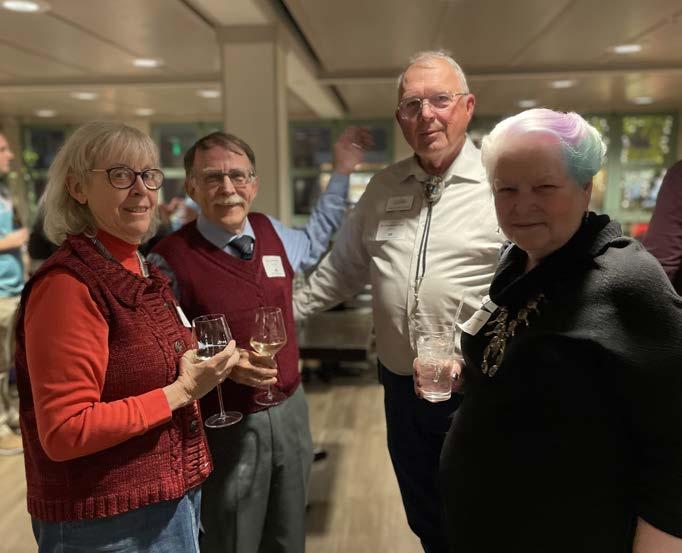







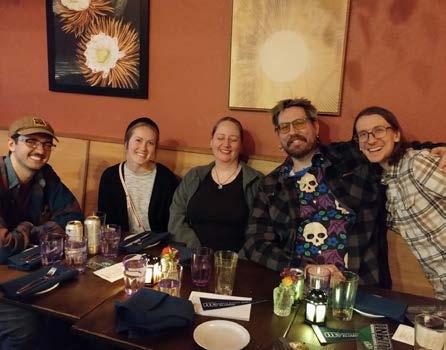







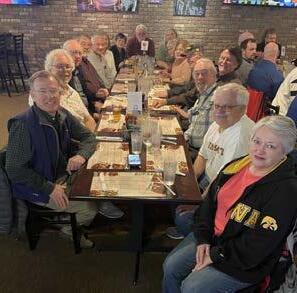










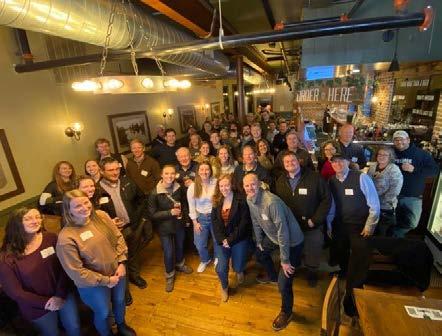






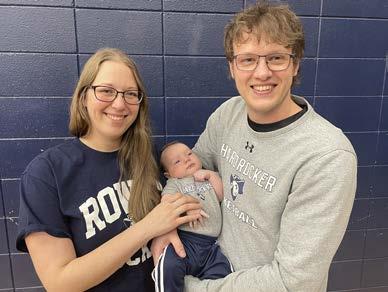

Have you moved recently?
Don’t miss out on chapter events! Invitations are sent to all alumni within a 60-mile radius of the event. Invites are generated based on your zip code, so make sure your information is current!
Update your contact information online at cara.sdsmt.edu/connect/update-my-information
Have an event idea? Let us know at alumni@sdsmt.edu
Stay connected with your Hardrocker family through local Area Chapters.
Area Chapters exist across the country to allow you to stay connected, network, socialize, and reminisce. Connect with fellow alumni in your area, wherever you live.
If there is not an active Area Chapter in your local area, get involved and help get one started. Shelli.Grinager@sdsmt.edu



At our home football games, our alumni tent becomes the Hall Inn. We don’t have a cowboy boot to drink out of, but you will see some familiar faces. If you come to a game, make sure to stop by and say hi or stay the whole game. Big thank you to Jeff Allen (ChE 77) for making our tailgate meals last season.

Join us for one of our 2024 home game tailgates. Tailgates start one hour before game time.
For tailgating prices or tickets, please visit gorockers.com/sports/2023/3/9/football-2023-season.aspx


This year, the March Medal, the highest award given to alumni for their service to the university, was awarded to Tim Doyle , who graduated in 1994 with a degree in chemical engineering and who now serves as a lieutenant in the Rapid City Police Department.
The March Medal is awarded annually to a graduate who exemplifies the spirit of electrical engineering alumnus Dr. Guy March through positive interaction with students, the institution, and South Dakota Mines alumni. Dr. March

months as a patrol sergeant, 18 months as a juvenile operations sergeant, and a short stint as a patrol lieutenant. Currently, he serves as the community engagement unit lieutenant. He is a member of the peer support team, physical fitness team, and mobile response team. He is also currently vice president of the South Dakota Fraternal Order of Police.
South Dakota Mines alumni are known for pursuing excellence in their careers. The Distinguished Alumni program was started in 1998 to recognize the outstanding contributions of South Dakota Mines graduates not only to the fields of engineering and science, but also to their communities and the university. Their accomplishments serve as an inspiration for future generations and highlight the great impact South Dakota Mines alumni can make in this world.
Navin Govind finished a master’s degree in electrical engineering in 1993 at Mines. Govind is a serial entrepreneur, investor, and executive with several years of proven success at Intel Corporation, Tarari, and Aventyn, Inc. He currently serves as founder and CEO of innovative digital therapeutic company 8chili, founder and executive chair of the b-eCare Connected Health Initiative, a venture partner at Evidence Ventures, an angel investor, an author of several original papers in peer-reviewed journals, and holds multiple issued patents. He is also a frequent speaker and industry faculty for health technology innovation, startup advisory, and health policy for digital health standards initiatives.

was named the second head of the Department of Mathematics in 1941. His leadership was an integral part of propelling the Alumni Association (which is now part of the Center of Alumni Relations & Advancement) into the active organization it is today. March Medalists embody the caring spirit of Dr. March, which has been a hallmark of the university that has been handed down over decades.
Doyle started his career with Polarfab, a private semiconductor manufacturer based in the Twin Cities. In 2007, he and his family moved to Rapid City where he started his career with the Rapid City Police Department, which has spanned 3 years in patrol, 6 months on the initial street crimes unit, 7 years as a school liaison officer, 18

Douglas Beck graduated from Mines in 1980 with a degree in electrical engineering. In 1996, after 16 years of serving at various companies and acquiring experience in engineering, marketing, and sales, Beck joined the family business, Harold Beck & Sons, Inc. in Newtown, PA – an electric actuator manufacturing company founded by his grandfather Harold. He has served as president and CEO since 2007, presiding over the introduction of new products, developing new markets, making substantial capital investments, and increasing international business. The company was named the 2022 Member Company of the Year by the World Trade Center of Philadelphia.
Lee Solid received a degree in mechanical engineering from Mines in 1959. Solid is the retired senior executive of Rockwell’s Space Operations in Florida, after serving more than 39 years in the company’s aerospace business. He oversaw the space shuttle orbiter launch processing engineering, payloads, and flight systems integration, which included manufacturing, repairing, and testing of space shuttle hardware at Rockwell’s Shuttle Logistics Depot in Cape Canaveral. He was a member of the Atlas-Mercury and SaturnApollo launch teams, which put the first American (John Glenn) into Earth’s orbit in 1962 and the first man (Neil Armstrong) on the moon in 1969, as well as launching the first space shuttle in 1982.
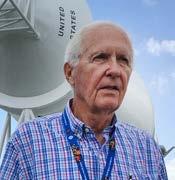
Brian Tucholke completed a degree in geology from Mines in 1968. He spent more than 50 years conducting geological and geophysical research in the world’s ocean basins, including 29 years at the Woods Hole Oceanographic Institution, and served on national and international scientific committees. His investigations have produced fundamental insights into structure and rifting mechanisms of continental margins, the morphology and tectonics of the global mid-ocean ridge system, and ocean basin stratigraphy and paleooceanographic evolution. As project co-leader for the Geological Society of America’s Geologic Map of North America he mapped, for the first time in the history of the geological sciences, the geology of the seafloor surrounding North America.

Audra Walsh finished her degree in mining engineering in 1995. She has nearly 30 years of experience at board, executive, and operational roles across the mining spectrum. Her impact on the field was recognized by Women in Mining UK who named her among the 100 Global Inspirational Women in Mining in 2020. Since 2016, she has served as CEO for Minas Aguas Teñidas, S.A.U. in Huelva, Spain, where she has led improvements in safety, finalized the expansion project in the processing plant, optimized the overall value of the operations, and directed the sale of MATSA to Sandfire in a $1.865 billion deal that closed in February 2022.


The Outstanding Recent Graduate Award was established at South Dakota Mines in 1984 to honor graduates who have achieved exemplary career progress and
recognition within 10 years of their graduation. Criteria for selection includes entrepreneurial effort, professional advancement, innovative research endeavors, technical or entrepreneurial accomplishments, community service, and industry or community recognition.
Everett Brill received his bachelor’s degree in geology from Mines in 2012 and his master’s degree in engineering management in 2017. Brill is an underground mine geologist with America’s Gold and Silver. His career started with Freeport McMoRan in New Mexico, where he learned the basics of mining geology including ore control with logging and interpreting blasthole samples, collecting ABA samples, bench face and ground mapping, data entry, planning and executing brown fields exploration drill programs, managing the geology core shed, and mentoring interns and new geologists.



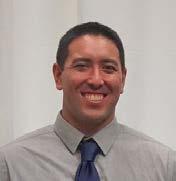
Joshua Green completed his degree in mechanical engineering in 2011. He has worked for Caterpillar for 11 years across three different states, 11 job roles, and four facilities. He is currently the operations group manager over all large diesel and natural gas engine production at the Griffin, GA, facility. He has been the recipient of multiple awards and recognitions, including the Large Engine General Manager Award for Quality.
Jasien finished her degree in math in 2011. Jasien is head of research with CPM Educational Program. Her
work is grounded in collaborative relationships with educational designers both outside and inside of schools. Outside of school, she collaborates with learning environment designers to study families’ mathematical play. Inside of school, she collaborates with designers to study ways to promote teachers’ and students’ joint intellectual thriving during mathematical inquiry.
Andrew Olson finished his bachelor’s degree in chemical engineering at Mines in 2012. He works for Thermo Fisher Scientific as the senior production scientist for their organic synthesis in Rockford, IL. Some of his work includes creating and working efficiently with multi-step organic synthesis in various scales to fulfill production goals for customers; engaging in process development for new products; and improving old processes and products that enable customers to make the world healthier, cleaner, and safer. He also oversees the training of other workers in the lab and production.
Andy Smith completed his degree in electrical engineering at Mines in 2011. His career began at Bechtel Marine Propulsion Corporation at the Naval Reactors Facility outside of Idaho Falls, ID, where he was responsible for troubleshooting process equipment and writing work procedures directing Naval nuclear work. He later moved to Denver, CO, where he spent eight years with URS/AECOM working in various power industries including generation, transmission, and distribution. In March 2021, he moved to Copenhagen, Denmark, and accepted a job with Semco Maritime, a global leader in offshore substation design and construction.
Industry knows to look to South Dakota Mines for highly qualified engineers and scientists. Alumni have access to South Dakota Mines’ career services platform, Handshake, where you can search for jobs and build a profile that employers will notice.


https://www.sdsmt.edu/Campus-Life/Career-Services/ About/Handshake/
Additionally, if you’re looking to relocate to South Dakota, check out dakotaroots.com.
dakotaroots.com
Advance your engineering management skills with one of our outstanding ONLINE master’s programs.

• Construction Engine ering and Management
• Engineering Management
• Mining Engineering and Management
Find out more at sdsmt.edu/DistanceEducation/
